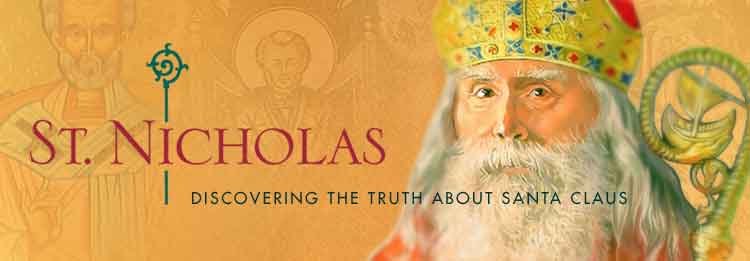Across Pacific Magazine
  News - God at Work - Humour - Heroes - Back Articles - Across Home Who
is Saint Nicholas? The
true story of
Santa Claus begins with Nicholas, who was born during the third century
in the
village of Patara. At the time the area was Greek and is now
on the
southern coast of Turkey. His wealthy parents, who raised him
to be a
devout Christian, died in an epidemic while Nicholas was still young.
Obeying
Jesus' words to "sell what you own and give the money to the poor,"
Nicholas used his whole inheritance to assist the needy, the sick, and
the
suffering. He dedicated his life to serving God and was made Bishop of
Myra while still a young man. Bishop
Nicholas became known throughout the land for his generosity to the
those in
need, his love for children, and his concern for sailors and ships. Under the Roman Emperor Diocletian,
who
ruthlessly persecuted Christians, Bishop Nicholas suffered for his
faith, was
exiled and imprisoned. The prisons were so full of bishops, priests,
and
deacons, there was no room for the real criminals—murderers, thieves
and
robbers. After his release, Nicholas attended the Council of Nicaea in
AD 325. He
died December 6, AD 343 in Myra and was buried in his cathedral church,
where a
unique relic called manna, formed in his grave. This liquid
substance, said to have healing powers, fostered the growth
of
devotion to Nicholas. The anniversary of his death became a day of
celebration,
St Nicholas Day, December 6th (December 19 on the Julian Calendar). Through the centuries many stories and
legends have been told of St. Nicholas' life and deeds. These accounts
help us
understand his extraordinary character and why he is so beloved and
revered as
protector and helper of those in need.
One of the oldest stories showing
St.
Nicholas as a protector of children takes place long after
his
death. The townspeople of Myra were celebrating the good saint on
the eve
of his feast day when a band of Arab pirates from
Crete came
into the district. They stole treasures from the Church of Saint
Nicholas to
take away as booty. As they were leaving town, they snatched a young
boy,
Basilios, to make into a slave. The emir, or ruler, selected Basilios
to be his
personal cupbearer, as not knowing the language, Basilios would not
understand
what the king said to those around him. So, for the next year Basilios
waited
on the king, bringing his wine in a beautiful golden cup. For Basilios'
parents, devastated at the loss of their only child, the year passed
slowly,
filled with grief. As the next St. Nicholas' feast day approached,
Basilios'
mother would not join in the festivity, as it was now a day of tragedy.
However, she was persuaded to have a simple observance at home—with
quiet
prayers for Basilios' safekeeping. Meanwhile, as Basilios was
fulfilling his
tasks serving the emir, he was suddenly whisked up and away. St.
Nicholas
appeared to the terrified boy, blessed him, and set him down at his
home back
in Myra. Imagine the joy and wonderment when Basilios amazingly
appeared before
his parents, still holding the king's golden cup. This is the first
story told
of St. Nicholas protecting children—which became his primary role in
the West. Another story tells of three
theological
students, traveling on their way to study in Athens. A wicked innkeeper
robbed and
murdered them, hiding their remains in a large pickling tub. It so
happened
that Bishop Nicholas, traveling along the same route, stopped at this
very inn.
In the night he dreamed of the crime, got up, and summoned the
innkeeper. As
Nicholas prayed earnestly to God the three boys were restored to life
and
wholeness. In France the story is told of three small children,
wandering in
their play until lost, lured, and captured by an evil butcher. St.
Nicholas
appears and appeals to God to return them to life and to their
families. And so
St. Nicholas is the patron and protector of children. Widely celebrated in Europe,
St. Nicholas' feast day, December 6th, kept alive the stories of his
goodness
and generosity. In Germany and Poland, boys dressed as bishops begged
alms for
the poor—and sometimes for themselves! In the Netherlands and Belgium,
St.
Nicholas arrived on a steamship from Spain to ride a white horse on his
gift-giving rounds. December 6th is still the main day for gift giving
and
merrymaking in much of Europe. For example, in the Netherlands St.
Nicholas is
celebrated on the 5th, the eve of
the day, by sharing candies (thrown in the door),
chocolate
initial letters, small gifts, and riddles. Dutch children leave carrots
and hay
in their shoes for the saint's horse, hoping St. Nicholas will exchange
them
for small gifts. Simple gift-giving in early advent helps preserve a
Christmas
Day focus on the Christ Child.
|
|
